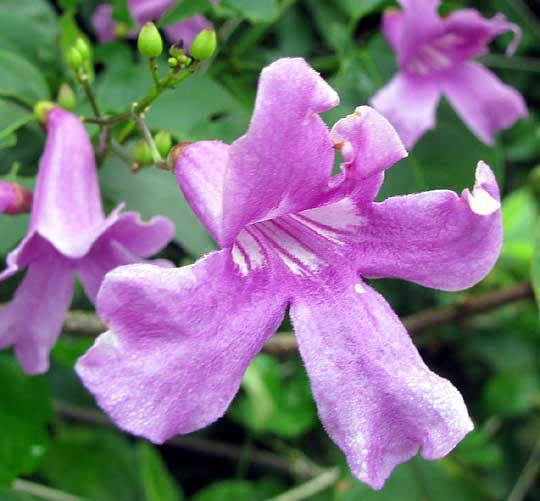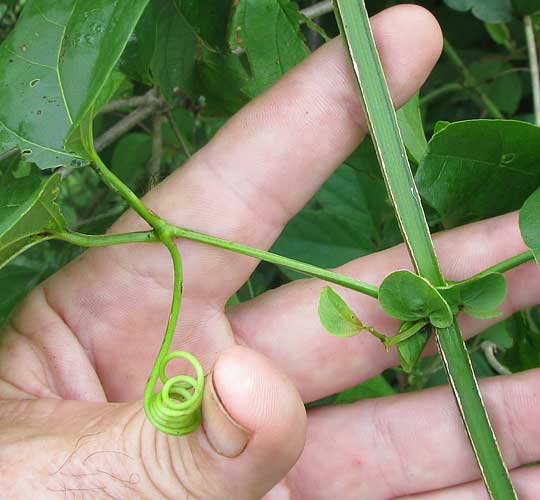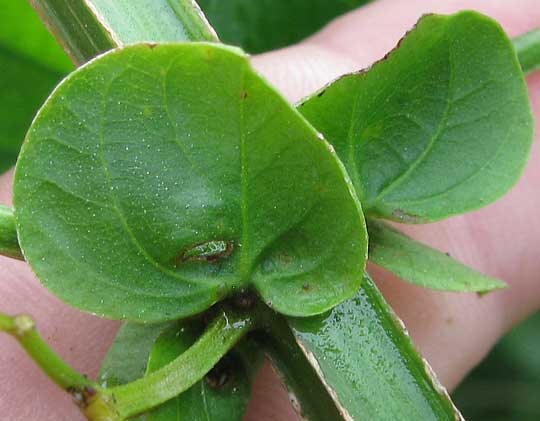Excerpts from Jim Conrad's
Naturalist Newsletter

from the September 12, 2010 Newsletter issued from Hacienda Chichen Resort beside Chichén Itzá Ruins, central Yucatán, MÉXICO; limestone bedrock, elevation ~39m (~128ft), ~N20.676°, ~W88.569°
NECTAR PROVIDERS PASSING THE TORCH
In July and early August a certain high-climbing, square-stemmed liana, or woody vine, bore conspicuous clumps of 1½-inch long (3.8 cm), purple blossoms. The vine was a member of the Trumpet Creeper Family, the Bignoniaceae, and its flowers were shaped like those of the North's Trumpet Creepers. The vine was Cydista potosina.
As August wore on I expected those high-hanging purple flowers to slowly disappear from the landscape, but they didn't. In fact, as September began, an even more eye-catching flush of purple flowers on high-climbing lianas began appearing. It was a second species of Cydista.
It was a beautiful case of a species taking over the job of supplying pollen and nectar to a certain size and kind of pollinator as the previous species' flowering period gradually ended. You might enjoy seeing if you can distinguish between Cydista potosina at the last link, and the species flowering now, shown at the top of this page.
A close-up of one of the new species' flowers is shown below:

I'll bet you can't see any significant differences between them. In those two pictures I can't, either. An important clue that we have a second species, though, is shown in the stem close-up shown below:

On the picture's right the squared stem slants upward. The petioles of two compound leaves connect with the stem above my middle finger. The clue that we have a new species is the leafy, ear-shaped items at the base of each petiole. Those are stipules, or modified leaves, which some species have but others don't. On Cydista potosina similar stipules are produced on young shoots, but those stipules soon fall off. On this second species flowering now, the stipules remain on old stems.
A close-up of the stipules better showing the squared stems, which actually are sharply "winged," is shown below:

The top picture on the C. potosina page shows older stems clearly lacking those stipules.
So, this second species is CYDISTA DIVERSIFOLIA, and it's very closely related to the earlier flowering Cydista potosina. Except for the stipules and the different flowering periods, I don't think I could tell the two species apart. Maybe by the fruits, but we don't have fruits yet. Also maybe C. diversifolia's stems are more sharply angled than C. potosina's, and my impression is that C. diversifolia tends to live in drier soils than C. potosina.
Both these Cydista species are used locally for weaving traditional Maya baskets. In certain areas both species have completely disappeared because of overharvesting for basket weaving.
Cydista diversifolia occurs from southern Mexico and the Yucatán south through most of the drier forests of Central America.